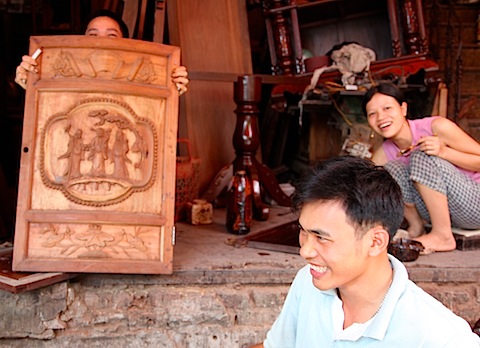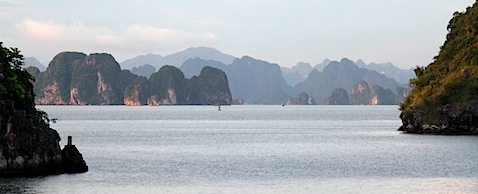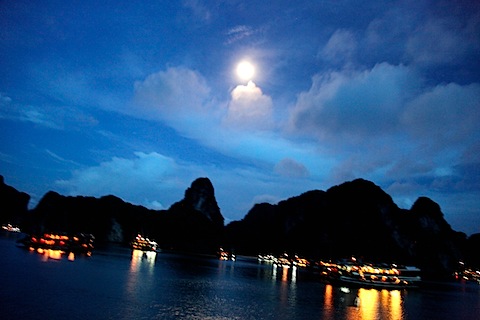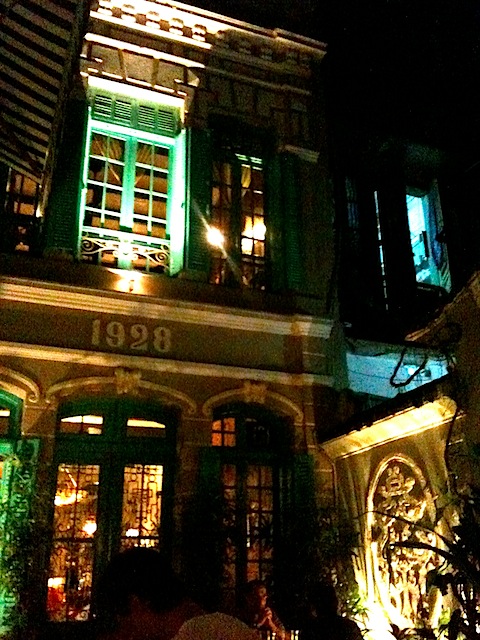1.
As I sit on the fifth floor terrace of the Illy Cafe, watching the sun set over the roofs of the city, I’m reminded of what is great about Hanoi. This is truly one of the prettiest cities in Asia.
The French, when not brutally oppressing the locals, tried to transport a bit of Paris to Hanoi. Many of the streets are line with trees that provide a pleasant shady cover as you walk down the streets.

Similarly, the legacy of French colonial buildings gives the city a feel that is very distinct from elsewhere in Asia. Some architects are now trying to combine the colonial buildings with a more modern approach, bringing another dimension to the city’s look and feel. Tanny Design has actually built a glass cube adjacent to a colonial building and the store stretches across both; the effect is striking.


The Old Quarter of Hanoi also provides a lot of the city’s charm. A maze of streets careen in seemingly arbitrary directions. Women ply the streets, carrying bamboo mats from which they sell everything fresh: sugar cane, dragon fruit, melons, rambutans, lychees, fish, crabs, snails, grapes, pomelos, chestnuts, oranges, mangoes, avocados, fried dumplings… The list could go on.

As you round street corners you stumble upon Buddhist temples, lakes, parks, markets and maybe even a cathedral or old city gates.
If you wander into those parks you may see comrades doing mass communal exercise. The women do lackluster aerobics. The men (and some women) jog. Older folks do calisthenics and stretches that make sense only to them.


However, all of this come at a cost. First, there are the ubiquitous touts. They are easily ignored and a mere nuisance.
The bigger issue is the traffic.
There is a complex rhythm to Hanoi. Every morning a flotilla of scooters and an army of buses and taxis fill its streets. Make no mistake that they are at war – with one another and amongst themselves.
Their weapons are the horn and the threatened inconvenience of an accident. The streetlights and lane marking of the city’s street form a trampled Geneva Convention.


If you find a good vantage point you can get a sense for how the battle unfolds. Buses are like tanks and plow their way through everything. The scooters are like fighter jets but instead of flying through gaps between clouds they’re seeking out pockets of empty space between other vehicles. (Note that this video is from the Illy Cafe; from there you can see the best and worst of Hanoi at once)
For the scooters this can mean driving the wrong way down the road, popping up on the sidewalk or running red lights. There is a kamikaze, zen-like calm to their movements: they will literally just drive into merging traffic, trusting that the experience will be like two schools of fish passing through one another. This technique, combined with many four way intersections that lack even a yield sign, means that all visitors will have ample opportunity to witness this situation.
Caught in the crossfire of this are pedestrians. And this is why some people hate Hanoi; it is literally a challenge to cross the road.
You have to follow the Kamikaze approach I described above as, in the rare instance that an intersection actually has a pedestrian crossing, it almost certainly will not be respected. Moreover, the sidewalk is almost always reserved for scooter parking, scooter repair or cooking, so you’ll frequently find yourself walking on the road as well as crossing it.
At the risk of introducing too many jumbled metaphors, you’ll quickly discover that you are the plankton of this automotive ocean and eaten by all.
Editor’s note: the loyal reader may lament the many discussions of traffic on this blog. We think it is an important topic to discuss as:
a) it has a disproportionate impact on the traveller
b) traffic plus environmental degradation (partially caused by traffic) are going to be huge issues these countless have to deal with in he 21st century. Many of the female street vendors in Hanoi wear masks (and this is also a business opportunity; witness the Hello Kitty smog mask)
Addendum: the other big issue Vietnam is going to have to deal with is a big, imbalanced population. Vietnam currently has 86 million residents. By 2050 this is expected to stabilize at 115-120 million. Unfortunately, the culture favours boys. There are currently 112 boys for every 100 girls (said another way, ~6% of pregnancies that produce girls will be aborted); in some areas the ratio is 135:100 (15%). The government is making it illegal to do anything to determine the gender of your baby before it is born.
2.
Vietnam is a country on the up and up. As you come into the city from the airport there are literally billboards coming out of the rice paddies. They advertise everything you’d expect in an industrializing economy: rebar, steel pipes, construction banks and beer.
The city is ringed with modern highways (if only modern highways meant modern driving) and high tech assembly plants from all the big players (e.g. Canon, Foxconn, Panasonic). Hanoi’s skyline is starting to be dotted with skyscrapers (thankfully the Old Quarter has been preserved so far) and new houses abound. A new rail link is being built to connect Hanoi with the port in Ha Long Bay-where a massive new suspension bridge connects the port to the expressway.
But this is only a prelude of what is to come. As you take the bus to Ha Long Bay you pass many different signs showing the various industrial/residential cities the government is planning to build in what are now fields. Similarly, new 20 foot wide, five storey houses line the road like gapped teeth. None have any windows on their sides, in almost gleeful anticipation that one day the road will be a canyon linking cities of industry.
Vietnam has a large population, cheaper costs than China and a better demographic dividend. Hanoi is a canvas as to how they plan on using this.
However, it’s not going to happen overnight. Many Vietnamese are still relatively poor-although moving in the right direction. You’re reminded of this when you see people getting their hair cut in the street:

You also see this in the massive discrepancy in prices between local and foreign/diplomat food. This is the only place in the world where I’ve had two meals that were two orders of magnitude difference in price. And in he same day to boot!
I bought a Banh Mi sandwich on the street for $0.75. Later that day we has dinner at The Green Tangerine (more on it later) for $75.
Similarly, the currency has a stunning range of notes. The smallest is 1,000 Dong, about five cents (some ‘entrepreneurial’ shopkeepers will price goods in odd multiples of 500; you’ll eat the change as the coinage doesn’t exist). The largest I’ve seen in common usage is a 500,000 Dong note – about $25.
3.
But let’s not forget that Vietnam is a communist country with no plans to change. As you walk around the city you may pass through Lenin Park. In both the city and the countryside you’ll see inspirational propaganda posters about how the state is creating a modern, clean, family-friendly country.
As you walk the streets you might see banners celebrating a state anniversary. When we were there it was the milestone 65th anniversary of Vietnam (65 sounds about as exciting as “Canada 125”). As a prelude to the final celebration, the week we visited they were feting the 65th anniversary of the Public Security Force. I wish that the FBI or the RCMP was able to have a similar day.

And then there’s Uncle Ho’s mausoleum and neighbouring museum. Alas, they were closed during our visit.


4.
John McCain’s fingerprints are all over Hanoi. He was shot down in 1967 and landed in Truc Bach Lake (Hanoi has many downtown lakes). There’s a concrete memorial commemorating the local anti-aircraft regiment’s vigour and accuracy (you find these across the city in the random locations where a plane crashed).

Later you can visit the Hanoi Hilton where he was interred. The museum is a fascinating piece of propaganda.
Its focus is on how awful the French were and how courageous the incarcerated comrades were in surviving their venal captors. There are many red flags and in the old execution room, some martial music plays to stir up patriotism.
The museum then turns around and infers that the shot down American pilots who spent he war there whiled away their days playing basketball, cooking and reading. There’s a photo of John McCain receiving medical care. What’s not mentioned is that he received some of his wounds from his captors who purposely delayed his medical care and that he can no longer raise his arms above his head.

Some similar propaganda occurs regarding the number of aircraft show down. The Vietnamese claim 3,700:


The accepted number is more like 1,700.
5.
One of the most interesting neighborhoods we saw was just north of the Gustav Eiffel-inspires train bridge. Not a lot of tourists go there as it entails crossing eight lanes of traffic.

After surviving the crossing, we walked through a massive market and disappeared into a web of narrow alleyways. The alleyways were fascinating as the traditional one story hovel is being replaced by four and five story buildings overhanging the alleys and sometimes only inches apart from their neighbors. Between the houses, the cramped quarters and the bundles of wires overhead, I felt like I was in a William Gibson novel.
Since we were one of the rare visitors to this part of the woods, we soon found ourselves being followed by children or asked to take photos of locals.

Our goal was to make it to the river. After a few false starts – and one very scary dog who hates white males – we made it. There’s not much to see, but we did learn that the poorest of Hanoi’s poor live there on boats.

6.
The reason we came to Vietnam wasn’t to see Hanoi but to get down to Ha Long Bay. We spent two days/one night there and had a joyful, surreal and confusing time.
The place is one of stunning beauty. The ragged, jungle covered limestone mountains jut out of the water and seem to stretch endlessly in all directions.


As you pass them, the changing perspective is fascinating; it feels like curtains of rock are sliding past one another in different directions.
And you can’t miss how the different angles of light transform how the mountains appear.


The confusing factor is the sheer volume of people who are on the water. An even mix of westerners, Vietnamese and upwardly mobile Chinese congregate in hundreds of boats.
When we visited a famous cave, I counted 22 junks and innumerable smaller boats. You had to walk counterclockwise as even looking the other direction meant that you were blinded by flashbulbs.
At night we moored in a cove with forty other boats (you can safely assume that each has 20 people and there are other similar coves).

When leaving, we passed through a channel against an armada of boats that likely could have evacuated the entire Allied force from Dieppe.
Our bus back to the city used every available seat – including the jump seats in the aisle. We were four abreast (and almost all Westerners) in seats that were designed for an average height of 5’7″. Charming it wasn’t (I recommend spending the extra cash to ensure that your tour takes a coach, not a minibus, down to Ha Long City).
There are too many people in Ha Long Bay and it is compounded by the curious habit of the tour groups to take everyone to exactly the same places – even though they told us there were other interesting places.
The surreal aspect of the trip was the evening’s entertainment. The Vietnamese love karaoke and have decided that every evening each boat should ‘make a party’ and sing karaoke.
Our boat was full of Brits, Vietnamese and Chinese and three cultures collided that night.

I sang a rousing redition of Guns ‘N Roses ‘Sweet Child O ‘Mine’. I sounded like a teenage choir boy whose voice was beginning to crack and had just been kicked in the nuts.
However, my falsetto garnered cheers from he Asian audience. When it ended, the computer algorithm that scores your song gave me a perfect 100! More cheers ensued. A cabin boy came up and congratulated me twice on how well I sing (this is not true-ask anyone who has done karaoke with me).
We finished our karaoke around 10, but the poor renditions of Celine Dion covers (an Asian favorite) continued until 11.
As I wrote this, I still feel a bit confused.
(And, if anyone ever wants to see it, I’ve got an awesome video of Wendy singing Michael Jackson’s “Heal the World”)

7.
Vietnam has also introduced me to a new fruit. I’d never had a custard apple before I came here. My mouth is drooling as I think about it’s delicious sweetness.

8.
Back in Apri, Wen and I went down to Washington to visit our friends Beth and Beau. We mentioned that we were planning on traveling for a while and might go to Vietnam. Beau immediately told us that his favourite French restaurant in the world was there. Four months later, we’ve been and we agree with Beau that The Green Tangerine is one of the best places we’ve ever eaten.
The restaurant has a lovely atmosphere. It’s an old colonial building set just off the street. You can eat in the building or the courtyard outside.

The settings are impressive but the menu is more so. The husband and wife team behind the restaurant have tried to combine elements of French and Vietnamese cooking into a new set of dishes. Sometimes they miss a bit, but most of the dishes are incredible. Here’s what we ate:
- Duck breast carpaccio in kumquat sauce served with orange and peppered chocolate sauce. This dish was a little too sweet (could have used twice as much duck or half as much orange)
- Fig tempura stuffed with goat cheese, nuts and grape presented on Vietnamese spiced bread. Fig tempura is one of the tastiest things I’ve ever had
- Pork rolled in O Mai and cognac served with vegetables baked in oven and a pyramid of vermicelli stuffed with Vietnamese herbs. The perfect balance of heavy (pork) and light (vegetables)
- (Dessert) Spicy necklace from the Far East: pineapple in curry, kumquat in Cointreau, tamarin fritters, black olive & honey sherbert plus cherry tomato baked with ginger. This was a set of flavours I’d never tried before – tomato & ginger? olive & honey? Who knew it could taste so good
The one dish we didn’t get a chance to try but would have loved to: rabbit in mustard and wasabi paste.
If you go, the restaurant’s at 48 Hang Be, just north of Hoan Kiem lake. Bookings are recommended, but Hanoi quiets down after 8:30; if you stop by then you should get a table relatively quickly.
A couple more comments on the food.
This is another country with delicious coffee. It’s quite bitter and sometimes the locals have flavoured it with a bit of cocoa or chocolate (only mildly) to smooth out the taste.

Every dish you try comes with one of the nicest garnishes I’ve ever seen. You get a little bowl of salt and pepper, a calamansi lime and occasionally a few slices of chile pepper. You squeeze the lime into the dish (removing the seeds) and then mix it all together. Voila, a tangier, spicier version of salt & pepper:

9.
A few other notes:
- In the airport, there’s a sign reminding you that no murder weapons – like laser guns – are allowed on the plane
- This, like Bali, is another place where women do manual labour. We saw an almost all-female paving crew. However, all the taxi drivers are male and all the street peddlers are female
- Speaking of taxi drivers (and all commercial drivers in general), they’re quite proud of the fact that they don’t work in the fields. They show this pride by not clipping a few of their finger nails (which would be impossible if you were a farmer)
- When I die and go to hell, my version of it will entail that I am a Hanoi bus driver forced to drive all day and listen to the saccharine and soporific local pop music
- If you go to Hanoi and want to buy some silk-made goods, head to the area around the cathedral in the Old Quarter. For restaurants and cafes, explore there or go north of Hoan Kiem lake (ideally at night, when the lake is it up). The Hapro Bon Mua cafe on the lake is a great place for a coffee and people watching
- At night, you can see people burning offerings (usually fake money) in the street:

- I’m pretty sure the national sport is badminton. It’s played in all the parks and as you walk around the national stadium (where a massive picture of Uncle Ho ensures he has the best seat in the house to all matches) you can’t help but notice that badminton gear is the most popular item for sale. It’s also the only town on earth where good badminton players can skip the line at restaurants and bars…
- Have fun watching the professionals dock the boat upon return to the Ha Long City public pier. The docking procedure consists of ramming into the parked boats ahead of you and then wedging them apart by driving into them. If you look at the corners of the stern of each boat you’ll notice that they are much more worn than the rest of the boats; now you know why
- The hotel was playing the Vietnamese equivalent of MTV over breakfast one day. They seem to be taking the “if you plant a million seeds, some of them will grow” approach to figuring out what is popular. Kitschy pop videos (picture emasculated boy with overstyled hair giving plush toy to his girlfriend) would be juxtaposed with the hard core rap of Tra Xanh. Quite amusing